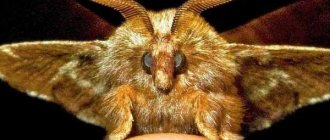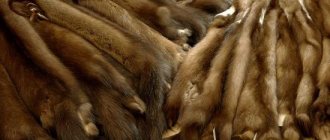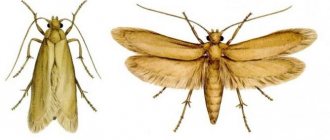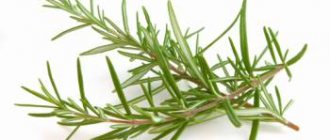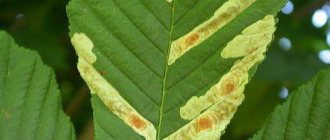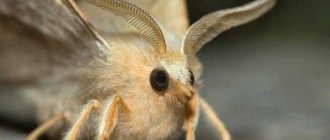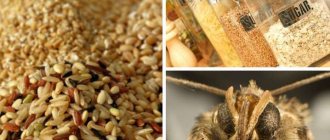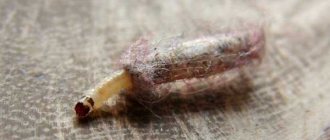What is food moth
A moth is a parasitic insect that feeds on various cereals, food mixtures, flour products, and also clothing.
Depending on what moths feed on, they are divided into several varieties, which we will briefly consider. The food moth is an individual that has wings whose dimensions reach up to 10 mm. Butterflies have no colors, so they have a gloomy appearance, which sometimes blends them in with the food where they live. Butterflies multiply quite quickly, which negatively affects the food supplies and clothing of household members, which they like to eat. The most common types of food moths are:
Flour butterfly. This moth can be distinguished by the brownish color of its wings, which often blends in with flour products, making the insect invisible. But you just have to look closely to find moths in a package of flour products.
This is what a common food moth looks like, which can be found in our kitchen.
Mill moth. This butterfly is found in rare cases, as it lives mainly in utility rooms where grain crops are stored. But occasionally, a butterfly can still be found in the kitchen in a bag with cereals such as corn, barley, wheat and barley. The moth has a significant difference: the upper part of the wings has a dark gray tint, and the lower part is white.
Cocoa moth. Despite the name, the cocoa moth feeds on various types of cereals, and you can meet it much more often than the preliminary representative. This moth has a lightish tint to its wings, so it blends in well with food.
Barn moth. This type of moth has a bright shade of wings, so it is almost impossible to confuse it with other species. This type of insect is very difficult to remove.
Despite the significant differences between different types of food butterflies, their larvae are practically indistinguishable from each other. The larvae hatch into caterpillars, which often have dimensions not exceeding 1.5-2 cm. Butterflies lay larvae directly in their habitats, so after the caterpillars are born, they begin active feeding. After a short time, an adult emerges from the caterpillar, which is ready for further reproduction.
Background. About moths and fur coats: who they are and what they look like
It turns out that the moth is not the hero of a fairy tale, not a contemporary of our grandmothers. The insidious insect even today encroaches on fur products, causing damage and causing frustration to the owners of fur coats, lovers of fur collars and hats.
And not many people pay attention to the inconspicuous moth that suddenly fluttered out of the wardrobe when it was opened. And the gray-winged butterfly is the very enemy from which it is important to protect yourself - and protect your fur coat.
Mole (the correct name is “moth”) is a common noun, even a collective one. Used to refer to the order Lepidoptera butterflies.
The ancient word, according to one version, originates from the Proto-Slavic mol (to grind, crush, damage), according to another, it is of ancient Greek origin and means “small livestock.”
Scientists find consonant words in the Irish language, while the English version of the name, moth (moth) - resembles the Slavic word only vaguely.
From the point of view of etymologists, this is a large group, including about 15,000 names of day and night butterflies.
There are about 40 species of moths. These are synanthropes - insects that lead an inextricable way of life with humans, settle in a dwelling, find food and shelter there, form colonies, and reproduce.
Among them are the real clothes moths (Latin Tineola biselliella), the hero of our story, the fur moth (Tinea pellionella), her friend the fur moth (Tinea laevigella), the carpet moth (Trichophaga tapetiella), which is capable of encroaching on fur, and some others, considered exotic in our latitudes.
For reference: insects are keratophages - they feed on products of animal origin, namely wool, skin, hair, etc.
Their food is keratin, a protein that is preserved in leather products, in the interior of fur coats, in pile, and in products made from natural wool.
You can tempt voracious butterflies with natural fabrics - but sometimes they can also encroach on artificial ones if there is no more attractive lunch nearby.
There are other species that are unlikely to end up in the wardrobe, but are pests: granary, cabbage, cotton, apple and others.
Moths through the eyes of an entomologist
All types of butterflies are dangerous pests; in fact, they are syntanthropes, keratophages. These are bisexual insects with a full development cycle and are capable of developing over several generations.
They lead a predominantly twilight or nocturnal lifestyle: during the day they look for secret corners, hide in the folds of clothing, in secluded corners of furniture.
During egg laying, midges show daytime activity. Adults are resistant to negative temperatures, but avoid illuminated areas.
During the year, one generation of pests develops in the middle zone, and two in the southern regions.
Moths are long-lived: the lifespan of a “coat moth” is about 200-250 days at t +18…+24 °C.
What does the creature that eats our fur look like? The fur moth is a yellow-gray, yellow-brown pest with a wingspan of 15-16 cm.
Imago (adult). The front wings have dark spots, the lower ones are light gray and transparent. The legs of the imago are equipped with shiny black claws that deftly cling to the fur of the fur coat; the abdomen is brown and glossy.
Eggs. Light gray, with a sculptural mesh pattern, elongated oval shape, large. Females lay eggs in the most secret places, choosing folds of clothing, seams or glued areas. The masonry matures in 4-6 days.
Larva. The caterpillars are worm-like, white in color, have a naked body, transparent skin, a brown head, have a powerful mouthparts, and eight short legs.
They live in the so-called covers that they create themselves. It serves as protection - by analogy with the shell of a mollusk, while the insects create them themselves. Life cycle from 10 days to 2-3 months. The size is large - length 6.3-8.4 mm.
Doll. Phase between pupa and imago. Wrapped in a silk cocoon, has elongated undeveloped wings, shiny and smooth limbs, a head, and is colored brown.
Why moths are dangerous for fur coats and how to find them
It turns out that butterflies are not able to feed - harm and danger come from caterpillars that eat everything in their path: the moth larva literally eats a fur coat!
She literally “mows down” the lint on her way as she moves, biting the lint. Even if she doesn’t eat the lint, the coat is damaged.
Eggs and larvae can remain in clothing for up to 10 months, damaging the fur and feeding on lint. As a result, voluminous bald spots form and the product needs repair. Depending on the size of the colony, the patches can be quite large.
It is important to destroy adult individuals, but if they are detected, urgently look for oviposition and larvae.
How to detect that a mink or any other fur coat is being eaten by a moth:
- The presence can be noticed by imagoes flying out of the closet.
- Along the “eaten” bald spots on the pile, along the cut “paths”.
- For shortened “cut” fur of products with long or voluminous pile - arctic fox, mouton, marten, nutria, fox, etc.
- The pile crumbles - it is “gnawed” by the larvae.
The presence of eggs can be detected by small light bumps, which can easily be confused with litter - if not for the correct shape and size of the egg laying.
To find the eggs, you need to blow intensively on the fur and carefully smooth out the long pile - they are located in the lower part.
It is important to locate the nest where the eggs and larvae are located. The nest is probably located in the depths of a closet, in the folds of clothing, and looks like a cotton ball, like thin flagella up to 0.5-1 cm long.
The main enemies of fur
All fur pests can be divided into two categories: those that eat fur (fur, wool and furniture moths, carpet beetle larvae), and those that feed on the skin of the skin (meatfly, bread beetle). The damage caused to fur products by these insects is irreparable! “Bald patches” on furs, holes in the skin and “chewed” pile (fur moth) are very noticeable both on transverse mink coats or fox vests, and on muffs, hats made of sable, astrakhan fur.
Therefore, the main rule of a caring housewife is to prevent insects from appearing in the fur, because, despite the existence of effective measures to combat them, these procedures are quite labor-intensive and are not always safe for the product.
What to do with a damaged fur coat
If a product is clearly damaged by moths, sometimes it is still possible to return it to its “marketable” appearance. It all depends on how severe the damage is: if there are a lot of bald spots or they are quite large, you will most likely have to say goodbye to your favorite and expensive item. But minor defects can be completely eliminated, although sometimes using drastic methods:
- the easiest way is to tint the bald patch to match the fur (a more difficult one is to paint the entire product in the color of its skin so that the “bald patch” does not catch the eye);
- a small bald patch can be cut out and the edges sewn from the inside: the repair area will not be noticeable;
- If quite large “bald patches” have already appeared on the hem or sleeves, you can change the style of the item by shortening it or cutting off the sleeves.
Expensive fur items in the wardrobe are not only beauty and an indicator of wealth, but also constant work to care for them. Systematic measures to protect products from moths guarantee the furs an ideal appearance without unwanted damage.
Fighting methods
One of the fastest ways to get rid of moths is disinfestation. There are now a lot of different aerosols in stores that quickly, without harm to the product and safely for humans, fight pests. These include Antimol, Raptor, Extramit, Clean House, Armol, etc.:
- Extramite: guarantees the death of insects a few hours after treatment. The effect lasts about six months.
- Raptor: the aerosol is suitable not only for combating existing moths, but also for prevention when storing fur coats. A single spray is sufficient for the desired effect. Does not spoil fur, including expensive ones. After killing the moth, it is advisable to spray the inside of the cabinets to prevent the parasite from reappearing.
- Clean House: to get rid of insects, you need to spray the entire apartment (especially cabinets, bedside tables, chests of drawers, where moths can appear). The products themselves do not need to be processed. You need to purchase the product at the rate of 1 cylinder per one-room apartment.
- Armol: a product with the aroma of lavender, which moths are so afraid of. Does not leave stains or other marks on the product. Suitable for getting rid of not only fur moths, but also clothing, wool and even food moths.
- Mosquitall: not suitable for all types of clothing, has a smell. Use in the same way as other aerosols.
To kill moths, you need to thoroughly spray the product on all sides, including in the folds, and also treat the cover (or a large plastic bag) from the inside, then place the fur coat in it and fasten it. Keep it this way for several days, during which it is advisable to additionally spray it with an aerosol inside the cover.
Aerosol Extramite
Aerosol Clean House
Aerosol Armol
Aerosol Raptor
If there are no special ones on hand at the right time, you can use other aerosols against crawling and flying parasites. But at the same time, you need to make sure that these preparations do not spoil the fur, leaving stains on it and a smell that does not disappear for a long time. Otherwise, the product can be taken to the dry cleaner, where it will be treated with heat, which will kill the moth, since it cannot tolerate high temperatures.
Fur coat cover
Among other means of control, you can use fumigators, but this will take time (about 2 weeks). In this case, the device must work in the cabinet itself, so you cannot do without an extension cord.
Sometimes special anti-moth sections are used against moths, but this product is good for repelling insects. It cannot destroy parasites, as it works on the basis of essential oils.
Among traditional methods, lavender essential oil or dried orange peels placed in cabinets are acceptable. But these means will not have a destructive effect either. They also mainly work only as a deterrent and are good as a preventive measure.
Case or vacuum bag?
A fur coat needs a cover in any case. It is not recommended to store either a separate product without a cover, much less furs of different colors: the coloring material from one of them can be imprinted on the other.
The safety of a fur coat depends not only on temperature conditions and humidity, but also on the quality of the cover in which it is placed. When choosing it, you need to take into account a number of nuances:
The width of the cover should not be less than the width of the product
Also pay attention to the length. It should be 10–15 cm larger than the size of the fur coat
This is necessary to ensure that the clothes do not wrinkle. Choose cases with side inserts. This will prevent the fur coat from being squeezed. The zipper connector should extend from the trempel to the very bottom, since this will make it more convenient to place the fur coat inside and you will avoid its deformation. When storing several fur coats, it is convenient to purchase covers with a transparent insert. This way you will have an idea of the location of the products without taking them out. But this insert must not be exposed to sunlight.
For a fur coat, only a cover made of natural material is suitable: linen, cotton or canvas. Such fabrics will help provide air access to the product. It is better to choose a case in black, brown or dark blue, since they do not transmit ultraviolet light well. But you must make sure that the paint does not transfer to the fur coat. To do this, you will need a regular damp cloth. Swipe the cover, and if you do not find any traces of paint on it, feel free to buy the product.
The cover, unfortunately, does not protect the fur from moths. Therefore, it is advisable to treat the material with a special spray or aerosol. For example, Mosquitall, Tornado or Raptor. This impregnation must be renewed every 3 months, as it loses its properties.
Don’t forget to put moth repellent in the closet or spray the cover of your fur coat
You can put pieces of cedar bark in your pockets: moths do not tolerate this aroma, and, accordingly, will not encroach on the fur coat. In addition, its smell does not disappear. Dry geranium, lavender or citrus peels are also suitable for this purpose. But folk remedies are inferior in effectiveness to aerosols and sprays. Do not use naphthalene. It repels moths well, but is a carcinogen, which is why many countries have banned its use for several years.
Preventive measures
- At the end of the season of wearing winter clothes, clean them with a brush; it also doesn’t hurt to go over them with a vacuum cleaner. Be sure to remove everything from your pockets, ventilate, dry and shake;
- Clean clothes should be stored in the closet; this will be the key to the absence of moth infestations. Before storing clothes, place dry citrus peels on the shelves; moths cannot tolerate such odors and will not settle there;
- Cabinets must be tightly closed so that insects cannot penetrate into any cracks and ruin outer clothing;
- Sharp temperature effects are an effective method against moth colonies. Ironing will kill moth larvae, or storing at a low freezer temperature will protect the fur item from invasion by clothing pests.
Preserving the original beauty
To avoid having to fight moth larvae later and to prevent moths from eating a mink coat, follow the basic rules for handling fur products.
When the season of wearing winter clothes is over, take the product to the dry cleaner, they will professionally remove traces of particles of human skin and sweat. A specially selected cover for a fur coat will protect the fur from insects. At least once a month, take it out of the closet, look through it and air it in the fresh air for at least a day. So that you don’t have to think about how to get moths out of your fur coat and not complicate your life.
If a mink coat is eaten by a moth, this can seriously hit the budget of the average family, because it is not customary to buy such expensive things every season. Therefore, you should take care in advance about how to treat a fur coat against moths so that such sad stories do not happen. The above-mentioned measures to prevent and combat moths are described in detail in the article. Follow simple rules and take care of your favorite things.
Is it possible to store a fur coat in the freezer?
Mink fur can deteriorate due to increased dryness and exposure to sunlight.
In addition, it is forbidden to keep a fur coat next to other things. It is worth considering that a white fur coat can turn yellow under the influence of unfavorable factors. To preserve the product, it is better to use a special freezer. Such storage protects the fur coat from exposure to the sun, dampness, moths, and high temperatures. Of course, you can simply put the fur coat in the freezer. However, it is much better to use a specialized refrigerator. In such places, special care is provided for fur coats.
The product is handed over for the summer, and when winter comes, it is taken away. The fur in such a freezer breathes because air is supplied into it, which blows over the product. For preventive purposes, reduce the temperature several times a month. This avoids the appearance of moth larvae.
In special storage rooms you can create ideal conditions for fur
Hardened
If you haven't managed to dry your fur coat, the inner layer may harden, as in the photo. If the mink coat is wet and rough, you will need to rip the hem of the coat and try to soften the inside. To do this, you need special products designed to soften the skin. If you are confident that you can handle it on your own, then start this painstaking work. If you are not confident in yourself, then it is better to seek help from specialists.
It is necessary to prepare a special solution. In one liter of water at 20-22 degrees, dissolve salt - 1.5 tablespoons and vinegar essence - 2 tablespoons. Apply the prepared solution generously to the skin and leave for 30-40 minutes. Then we begin to gently knead the skin with our hands. This procedure should be done three times, taking a break of 2-3 hours. Now the fur coat needs to be allowed to dry thoroughly.
After washing
After washing, you suddenly discover that your favorite mink coat has shrunk. Most likely, the skins of your product were not of high quality. This defect is difficult to correct. Here you also need the help of professionals who, with the help of additional pieces of similar fur material, can increase the size of the fur coat.
Folk remedies for potato moth
There are a number of popular techniques that will help reduce the number of pests in the garden. For example, caterpillars will not feed on tubers if a little ash is thrown into the holes when planting. There are also recipes for spraying plants during the summer (2-3 times per season):
- Combine a glass of wormwood herb and the same amount of ash, pour 3 liters of boiling water, leave for 2 hours.
- Mix 100 g of grated laundry soap, 200 g of wormwood and 50 g of onion peels. Brew 5 liters of boiling water and leave for 3 hours.
- Boil a kilogram of celandine stems for 10 minutes in 5 liters of water, let cool. Dilute the product with 5 liters of water before use.
Let's recognize the enemy by sight
Can food moths eat fur coats? No, for this type of insect the favorite type of food is dry cereals and dried dried fruits.
food moth
The food butterfly also differs from the clothes butterfly in appearance: it is larger in size and has a “disheveled” appearance due to the special structure of the wings.
Clothes moth
Having figured out what kind of moth is eating a fur coat, it is important to determine whether it is the culprit for the fact that bald spots and even holes have appeared on your favorite thing. The first signs of its presence include:
- loss of a presentable appearance by a fur item;
- the presence of short, as if cut, hairs in a storage case or in a closet;
- the appearance of unnatural folds in damaged areas;
- hair loss after touching the surface of the fur;
A fur coat or other product gives off a slightly unpleasant and persistent odor.
Natural fur coat
Special refrigerators
A set of measures will help protect fur clothing from moths, which includes:
- special storage;
- mechanical protection;
- folk remedies for prevention;
- chemicals.
The best option is to hand over your fur coat to one of the fur storage companies. Such companies have special refrigerators for storage: low temperature prevents the flesh from drying out on hot days and keeps the pile in good condition. But this method has several disadvantages:
- Luggage storage services are not cheap;
- this service is usually provided only in large cities;
- According to reviews from many owners who have deposited their fur coats, their appearance in the fall often leaves much to be desired, since not all organizations perform their duties efficiently.
On top of that, not every owner of a mink coat is ready to part with it for six months.
What to do if there are already moths
In war, all means are good, therefore, when entering into battle with a butterfly eating the fur on your favorite fur coat, you should try each of the known means.
- Treatment. Professional insecticides for contact treatment are sold at any hardware store. The popular “Raptor” or “Moskitol” will not patch holes in clothing, but will destroy both larvae and adults without causing damage to either things or people (if they are used correctly, observing the necessary safety measures).
- Cleaning. Seasonal cleaning of fur items in specialized studios is the easiest way to get rid of pests. In addition to getting rid of moths, the studio will also improve the appearance of the fur, repair frayed hems and sew up any resulting holes.
- Storage. A storage case impregnated with insecticide will not only protect clothes from pests, but also protect them from dust and mechanical damage while in the closet (video).
- "Aromatherapy". Adults seeking to lay eggs in a soft mink or arctic fox will be deterred by the smell of lavender, geranium, tangerine or orange peel. You can make such “repellents” yourself. To do this, dried peels or grass are sewn into a linen bag and laid out among the compartments of the wardrobe. A proven method that our grandmothers used to save furs from pests is naphthalene. The product is effective, however, not only insects, but also many people do not like its smell.
"Paddings." Special tablets with or without a repellent odor will help to exterminate existing ones and prevent the proliferation of new individuals. In addition to tablets, you can purchase balls, pendants or sections that operate without contact.
“Symptoms” of moths
It is almost impossible to detect moth offspring in fur products at an early stage. The eggs of the parasite are invisible to the human eye not only because of their small size, but also because of their translucent “design.” Attached with the help of a special adhesive, they develop into larvae, which begin to actively eat the hair thread, leaving the skin itself untouched. This is why bald spots appear, not holes.
Unfortunately, we begin to sound the alarm only when we encounter an adult in the apartment. The moth lives only one day, but during this time it manages to lay several dozen eggs. Therefore, if you give up searching for parasites for a day, you risk raising a ruthless army.
For prevention
Why do moths eat fur coats? Because for her it is the best source of nutrients. The fur product attracts insects with its smell, which they pick up from a great distance. A “pleasant addition” for pests will be the presence of contaminants on the surface and inside of fur or wool clothing. Worn sleeves and collars with traces of human sweat and sebum will be a kind of beacon for moths.
In order for your favorite thing not to turn into a “table and home”, it must:
- regularly ventilate and shake;
- store in an individual case on a shelf or compartment separate from other things;
- dry well before sending for summer storage;
- carry out seasonal cleaning in the studio before and after winter;
- when storing, turn it inside out and wrap it in newsprint (pests don’t like its smell);
- treat with repellent insecticides.
Simple rules for using and storing fur items will protect them from damage by harmful insects. Saving a fur coat or fur vest is much more difficult than promptly cleaning the fur from existing contaminants and purchasing a special cover.
Subtleties of home storage of different furs
Each type of fur has its own wear and storage period. To keep your clothes in perfect condition, you need to remember a few simple rules.
Mouton
The most durable is the mouton. This fur coat is often used as an everyday option. They store it, like others, in a dark, well-ventilated closet. But mouton fur has one peculiarity - if the dirt is not removed from it immediately after the stain appears, then it will be almost impossible to do so later. Therefore, the fur coat must be thoroughly cleaned before storage.
Mouton is stored for a long time in cold and dry conditions
The enemy of the muton is heat . The product is placed in a closet where even artificial light does not penetrate. The optimal temperature is 8–12 °C, otherwise the fur may lose its shine and acquire a musty smell of rags. To protect the mouton from deformation as a result of its own weight, the hangers must be exactly the width of the shoulders of the product.
Mink
Mink is a capricious and not wear-resistant fur . This product should be stored hanging on soft hangers. A suitable option is a cabinet made of cedar, since such wood practically does not allow moisture to pass through and repels moths with its smell. It is advisable to choose a storage case made of fabric to ensure sufficient breathability.
Mink is a delicate material that requires care
Before storage, be sure to clean the fur from dirt; it is advisable to entrust this process to dry cleaning specialists. Mink is a very delicate material that can be easily damaged.
How to store products made from nutria, goat and other types of fur
Nutria and beaver fur is the most wear-resistant and durable. Such fur coats will last for many years, maintaining their appearance unchanged. But there are still some storage nuances.
- The beaver product should be kept in a cool, dry room. Exposure to dampness and heat instantly spoils a fur coat, making it faded.
- Nutria fur is more durable. It is enough to protect it from moth attacks.
Both of these materials must be thoroughly dried before being put into the closet.
- Rabbit fur is stored in the same way as mink. It is important to prevent caking of the product, as well as moth attacks.
- The fur of raccoons, foxes and chinchillas is easily susceptible to creases. Products are stored only on hangers. In this case, it is necessary to ensure that they are well straightened.
- A goat fur coat is placed on wide hangers, this allows it to maintain its shape. Otherwise, the storage conditions are not particularly special.
A few more tips:
Now you know which plant repels moths with its smell. Finally, remember a few important rules:
- Anti-moth plants should be used immediately, avoiding severe infestation of the room with butterflies;
- Change the products periodically - once the insect gets used to one scent, it will stop reacting to it. Remember, dry herbs retain their fragrant properties for 2-3 months;
- For an enhanced attack, use a whole collection of aromatic plants.
Where do moths come from in an apartment and how to get rid of them? This is interesting to know!
Precautionary measures
When purchasing an expensive fur item, it is a good idea to thoroughly inspect the pile, since reputable salons do not guarantee that the product is 100% moth-free. Thin stripes of bald spots may indicate the presence of parasites in the pile. After purchasing, even if nothing suspicious was found, hang the product on the balcony at home for two or three days. Ventilation will have a good effect only in dry weather; dampness can only aggravate the situation. And the temperature range can be different; both extreme heat and persistent frost have a very detrimental effect on the faces.
Moth repellent
How to protect a fur coat from moths? To preserve the product in its original form, it is necessary not to give harmful insects a single chance to appear and survive. To avoid accidental infection of a mink coat with moths, you need to ensure that such outerwear is stored in a separate closet. Special sprays will also make a significant contribution to preserving the product from parasites. How to treat a fur coat against moths so as not to harm it? The most effective and proven brands of aerosols are:
- Antimol;
- Raptor;
- Armol.
Periodically, these products are applied to the surface of the fur product, as well as to the inner walls of the closet, to protect the fur coat from moths. They will not cause any harm to the product - that is, they will not leave traces of spraying and will not give it an additional odor.
One of the original innovations in the fight against insects and excellent protection of a fur coat from moths is a fumigator. Without expending your own energy, you just need to plug it into an outlet, and then its radiation will protect the product from moths. For a short time, use an extension cord to place the fumigator in a closet. Firstly, it will not allow larvae to develop in clothes, and secondly, a butterfly that accidentally flies into the closet will quickly become disoriented and die.
Preparing a mink coat for storage at home
Cleaning should be done at a dry cleaner or yourself. Before placing the product in the closet, you need to inspect and shake off dust. Iron carefully. If you find stains or dirt, you should immediately begin removing them, otherwise your favorite item will be damaged.
Attention! Do not comb the pile so as not to damage it.
After shaking and smoothing, it is advisable to follow these steps:
- Hang the mink coat on wide hangers and apply dry shampoo to dirty areas. Instead, talc and semolina are used. It is not recommended to do dry cleaning using “grandmother’s” methods. Vinegar, ammonia and medical alcohol, gasoline, kerosene - set aside. An unpleasant odor may appear, and if used incorrectly, the product will be damaged. If greasy stains appear, use sawdust, yellow stains - animal shampoo, traces of foundation and lipstick - vodka, vomit - starch.
- The shine of the mink coat will help restore the solution of lemon juice and glycerin. Combine the products in equal quantities and apply to the product with a spray bottle, wipe with a paper towel in the direction of the pile and leave to dry.
- Using a special brush, comb out the loose powder. Comb in the direction of the pile. The comb should be soft, with rare teeth.
- After cleaning, dry the mink coat. Leave clothes on the balcony so that ultraviolet radiation does not reach them. Hang on wide hangers, hook onto a rope. Do not use clothespins; they have a deforming effect.
To clean the lining, use stain removers or foam for cleaning clothes. Apply only after wiping with a brush to remove dust and dirt. Before storing in a closet, the mink coat must be thoroughly dried.
Important! Sprays, foams and lining stain removers should not be allowed to come into contact with the fur portion of clothing.
The preparatory stage ends with fastening the fur coat with all the buttons. The product is hung on hangers with an additional clip to support the case.
Storage
How to store a fur coat from moths? There is an excellent solution to this issue. Covers for fur coats against moths, the least energy-intensive option for the owner of furs. By purchasing such a protective product at a reasonable price, you only need to pack your favorite item in this case in time, and then, without unnecessary actions and worries, it will be safely stored in it until the next season. The trick is that the inner surface of the case is impregnated with a special compound that repels harmful insects. Since the case is hermetically sealed, there is no risk to the fur product until next winter. As an alternative to a specialized storage container, you can also use the packaging case in which the mink coat was purchased.
Choosing a case
Fur should be stored in colored cases made of natural fabric.
Under no circumstances should a fur coat made from natural fur be stored without a cover. Otherwise, the product will fade, become wrinkled and lose its luxurious appearance forever. The cover must be fabric. Vacuum bags for storing fur products are contraindicated. The fact is that, firstly, the fur coat will have to be folded, since it is almost impossible to find a cover of a suitable size. And secondly, condensation forms in a closed bag, which negatively affects the villi and inner parts - treated leather, the basis for fur. So, what are the requirements for a fabric cover?
- It should be breathable and made of natural fabric (linen, cotton, canvas).
- The width of the bag should be slightly larger than the width of the fur coat.
- The length should be 10–15 cm longer than the fur product.
- The insert on the cover should be located on the side - this is the only way the fur coat will not be squeezed, and it will be much more convenient to pack it.
- It is better if the cover has a transparent “window” - when storing several fur items in one closet, it will be more convenient for you to figure out which is which.
- The sun's rays should not fall on this transparent insert, since ultraviolet radiation negatively affects fur even through polyethylene.
- The color of the cover should repel sunlight, so rich blue, dark brown, and black are preferred (to prevent the paint from transferring to the fur coat, when purchasing a packaging bag, run a damp cloth along the inside - if there are no marks left, you can buy).
- Before placing the fur coat in the cover, treat it with anti-moth spray, and then repeat the treatment every 3 months.
If it's already started
When a product is infested with moth parasites, this is clearly visible in the bald areas of the fur. However, there are less noticeable signs that should be identified in time to prevent damage to the entire fur:
- The fur coat begins to crumble slightly, lint accumulates at the bottom of the closet;
- On the affected area, the pile is directed in different directions, while all the fur lies in one direction;
- Crumpled fur in the path of larvae movement.
Potent insecticide aerosols will give excellent results in the fight against moths. Moth repellents for fur coats that will quickly and effectively help kill insects:
- Extramit;
- Antimol;
- Raptor;
- Clean house;
- Armol.
These preparations are sprayed over the entire surface, as shown in the video. In a well-ventilated area, lay the fur coat horizontally, treat it both outside and inside (from the lining side), including the pockets. After this manipulation, place the product in a case, also pre-treated with spray. Leave the mink coat in this position for a week, and then thoroughly ventilate it in the fresh air.
How to bring it into proper shape
When all measures to get rid of parasites have been taken, all that remains is to mask the flaws resulting from damage to the fur by moths in the following ways:
- Narrow bald spots can be easily painted with a felt-tip pen to match the fur;
- Have your entire fur coat repainted at the dry cleaners to match your skin color;
- If there are bald spots only at the bottom of the product, then you can cut off the hem, thus creating a short fur coat or sheepskin coat, and the item itself will be preserved;
- When the defects are in the area of the collar and shoulders, it is easily draped with a shawl, scarf or hidden under a huge brooch.
This article describes in detail recommendations on how to preserve a fur coat from moths. By using them for preventive purposes, your favorite mink coat will remain safe and sound for a long time. When a moth has done a little work on a fur item, certain actions will also help return it to its previous appearance.
General rules
How to store a fur coat in the summer so that it does not lose its original shape, shine and rich fur color? To do this, the mink needs to create certain conditions:
Ambient temperature +2+4°C.
Mink fur, like any other, loves cool air. The optimal temperature helps maintain the elasticity of the pile and prevents the appearance of moths and carpet beetles, the larvae of which can cause irreparable damage to the fur coat. It is difficult to create such a temperature at home, so during the summer you need to take out the fur coat several times and hang it in a well-ventilated area or on cool days outside.
We recommend that you read
In large cities there are companies that provide services for storing fur products in special fur refrigerators, but for most owners of mink clothing this service is not yet available.
Air humidity 45-65%.
Dry air has a bad effect on the condition of the inner skin (the underside of the tanned leather) - it makes the inner skin brittle. Humidity of 45-65% will prevent the tanned leather from drying out. Usually in city apartments the air humidity does not exceed 25-30%. To provide “comfortable” conditions for your favorite fur coat, it is worth purchasing an air humidifier that will create a good climate not only for the fur product, but also for the health of the household.
Lack of sunlight.
You need to store a mink coat in a closet or dressing room, where there are no light sources. Moreover, the sun's rays should not reach there - from their influence, dark fur “burns out”, loses its color saturation and shine, and a light mink acquires an ugly yellow tint. Electric light bulbs have the same effect on fur. If lamps are installed in the storage for fur coats, the product should be in an opaque case.
Free space.
The distance between the fur coat and other things should be at least 20 cm. Free space is necessary so that the fur does not wrinkle or break. In addition, air must circulate around the fur coat, thereby maintaining the necessary humidity.
Hanger.
During storage, the fur coat should hang on a hanger with hangers equal in length to the shoulders of the product. If the manufacturer does not provide a suitable hanger with the fur coat, then you should choose a wooden one with wide rounded shoulders. A base that matches the size of the shoulder part of the fur garment will avoid deformation of the product.
In the summer, a mink coat should be stored in compliance with the specified parameters, this is the only way it will not lose its attractive appearance until the next season.
We store things correctly
Proper storage of things not only provides reliable protection from hungry parasites, but also allows the fur to maintain its noble appearance. In the winter season, fur coats, hats, and fur vests must be protected from moisture. In conditions of high humidity, the moth will reproduce safely and enjoy life. Items exposed to rain or sleet should be immediately hung on hangers, combed and dried at room temperature. You cannot use a hairdryer, gas burners or heaters.
In the summer, you should store clothes more carefully:
- First, before packing, clean your fur coat from stains. Moreover, it is better to use dry cleaning services,
- secondly, check the reliability of the buttons and the condition of the locks. Replace them if necessary,
- Next, we purchase a special cover for the fur coat. The cellophane option immediately disappears: under such material the fur coat will dry out and the fur will lose its proper appearance. The ideal option is cotton or linen. The fabric will provide the necessary breathability.
Moths and their larvae, which damage fur, do not like the strong smells of citrus fruits.
- in the room where the packaged fur coat is stored, the following conditions must be observed: air temperature - 0-19 degrees Celsius, humidity - 30-50%. If it is impossible to achieve these indicators, then the product must be regularly (once every 5-6 weeks) removed from the case for ventilation and combing,
- Periodically inspect your fur product for the presence of moth larvae. The best option would be to clean the fur with a vacuum cleaner during general cleaning of the apartment,
- Place only clean items in the closet where the packed fur coat is stored.
These simple measures can preserve the “health” of your fur coat for more than one season.
Actions to take if a fur product is contaminated
First, you should find out that it is a moth that has settled in your fur coat. Since the caterpillars of this insect are always hidden and are located at the base of the pile, it is quite difficult to notice them with the naked eye. Having settled in thick fur, they weave small silk cocoons, which are replaced after each molt. The food for them is the lint; they do not touch the skin.
Signs of infection
The main sign of moths in your fur coat is individual bald spots. Empty areas indicate that the infestation is still minor. What other symptoms might there be?
- The fibers stick out in different directions, the fur is crumpled and looks sloppy.
- Hairs accumulate on the floor under the fur coat, which the caterpillar has cut off in order to move to the neighboring area.
- In places where the larvae move, the fur is crushed.
The fur coat will be most damaged where the caterpillar crawled. To saturate it, it needs a small amount of lint, and when moving, it simply cuts off the hairs that are in its path.
The surest sign of fur infection is a large accumulation of butterflies in the wardrobe and caterpillars, which are already visible to the naked eye. In this case, it is necessary to take decisive steps to destroy them.
How to save the product?
Now it’s time to figure out what to do if your fur coat is eaten by a moth. Everything here will depend on the scale of the damage caused.
- If the damage is numerous, then, unfortunately, the fur coat cannot be saved and the expensive item will simply have to be thrown away.
- Small flaws and a small number of narrow “paths” can be painted over with a marker matched to the color of the pile.
- Sometimes it’s easier to dye the fur coat itself to match the color of your skin.
- One small bald spot can be hidden in a fold by cutting out the damaged area and stitching the skin from the inside.
- If the bald spot is large, but only one, then it can be hidden under a brooch or an original patch.
- If there is damage only on the hem, but you don’t want to throw away the fur coat, then you can shorten it by contacting a tailor.
Popular questions
When housewives purchase an expensive fur product, they may have various questions about fur moths:
- How to detect moth eggs in a fur coat? It is almost impossible to detect them. Moth eggs are so small that they are difficult to see with the naked eye. They do not exceed 0.5 mm in length. They are usually white in color and oval in shape. Under favorable conditions, larvae appear within 7 days.
- What are the signs of a moth infestation? Since the larvae cut out grooves, folds or wrinkles appear on the product. The larvae also shear off the fur, which leads to the formation of bald patches. In addition, moths are actively fluttering around the room.
- Where else can you find fur moths? Its caterpillars can be found in horseradish, cayenne pepper, saffron, bay leaves, mustard seeds, orris, opium poppy fruits, almonds, and peanut husks. In addition, this parasite can damage stuffed animals, unique zoological objects, tobacco stocks, as well as raw sheep wool.
